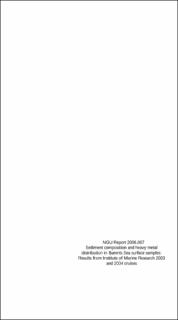| dc.description.abstract | A total of 73 marine sediment samples from the Barents Sea collected with multicorer equipment in 2003 and 2004 have been analysed for grain size distribution, TOC, carbonate content, clay mineralogy, main elements and trace elements, including heavy metals. This report gives the analytical results for the 0 - 1 cm sediment samples.\rThe 73 sampled locations cover different depositional settings, including marine environments influenced by the North Atlantic Current (NAC) and the Norwegian Coastal Current (NCC) in the southern part of the Barents Sea. In the northern part of the sampled area, where the marginal ice zone forms a marine environment with high biological productivity and ice-transported material, The Storfjord Trough south is a depositional environment influenced by the erosion and transport of land-derived sedimentary material from Spitsbergen to the north. The grain size distribution, divided into clay (< 2 \u00B5m), silt (2 - 63 \u00B5m), sand (63 - 2000 \u00B5m) and gravel (> 2000 \u00B5m) shows that the top 1 cm varies significantly. Silt and clay, i.e. < 63\u00B5m grain-size, defined as the \"mud\"-fraction of sediments, constitute 5 - 85 % of the sediments. Inorganic contaminant concentrations are generally low, with a few exceptions. Arsenic (As) is the single inorganic contaminant, which is present in high concentrations, corresponding to Class III (marked pollution level) according to the Norwegian state pollution authority guidance (SFT 1997).\rNickel (Ni) has 28 samples classified as class II contamination sediments (significant concentration). The heavy metals including mercury (Hg), lead (Pb), cadmium (Cd), copper (Cu), chromium (Cr), Zinc (Zn) all have concentrations within the Norwegian Pollution Control Authority Class I (no - insignificant contamination concentration). Elevated barium (Ba) concentrations are encountered in the Håkon Mosby mud volcano area at the continental margin and near the Snøhvit gas\/condensate field. The latter might be due to emissions of barite (BaSO4) additive during drilling operations according to reported dispersion during drilling operation of well NOCS 7121\/5-3 in 2000. | |

